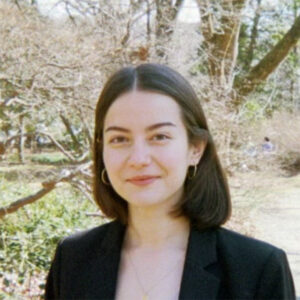
This past summer, third year Ph.D student Alma Huselja was given the opportunity to conduct research at one of the most significant institutions for Holocaust research, the United States Holocaust Memorial Museum (USHMM) in Washington, D.C. From June to August, Alma conducted research on her PhD dissertation, which examines “Aryanization” in the Independent State of Croatia (Nezavisna Država Hrvatska: NDH).
After defending her MA in December 2021, Alma was eager to begin researching on a larger scale. “I knew that I wanted to continue on the topic for my dissertation. While I had valuable experience researching in a local archive, to take my research to a larger scale, I needed to look at documents from other parts of the NDH, national-level ministries, and so forth. The issue I faced arose from how spread out the sources are from archive to archive and country to country. The organization of NDH offices means that sometimes sources are not always in the cities you’d expect them to be. That already entails a lot of travel between cities in Croatia and Bosnia. And, since Belgrade became the Yugoslav capital, many documents pertaining to the NDH, like postwar war crimes trials, are kept in Serbia. The logistics and costs, both time and monetary, of visiting these archives over one summer were simply impossible.”
At the USHMM, however, Alma was able to access different archives and archival materials from a centralized location. Not only did this help with her research over the summer, but also for planning future research trips. “It was a place where I could conveniently begin my research and get a base of knowledge for what sources are out there. This would help me in preparing my prospectus as well as funding applications for future research,” Alma told me.
The previous summer, Alma had traveled to a local branch of the Croatian State Archive in Varaždin to supplement the research she had already conducted with the town’s digitized newspapers and oral histories from local survivors. Since she was researching on a smaller scale for her MA thesis, she was able to take time with each document while at the archive, taking notes and mentally processing the documents as she went through them.
At the USHMM, Alma had to learn to take an entirely different approach to tackle the amount of collections she needed to view. Instead of taking time with each document, she had to focus on collecting as many documents as she could while there. Since these will be documents that she will be using not only on her Ph.D thesis, but on projects afterwards, her priority was to collect rather than to fully process.
Some of the documents Alma examined were similar to ones she had looked at in Varaždin, but on different levels in the chain of bureaucracy. “I spent a lot of time looking at documents from various levels of the NDH state apparatus. Alongside local-level documents from town councils, there were plenty of collections from the Ministry of Treasury, the Ministry of Internal Affairs, the Ustaša Surveillance Service and so on. I was familiar with the town council documents from past research, but the higher-level documents were completely new to me. These also included letters written to each branch of government – whether internal circulars or letters from other individuals. Many were documents detailing the process of expropriation, like trustee contracts and itemized inventories of property and their valuations.” Alma also continued listening to oral histories from survivors and bystanders to violence as well as examining newspapers and cultural organization documents, like those from interwar Yugoslavia’s Jewish communities.
Alma also discovered archival connections she had not considered looking at before researching at the USHMM: “There were also documents from archives I hadn’t thought of that I was pointed towards as potentially useful. This included the Russian State Military Archive, which keeps documents captured by the Soviets from the Axis Powers, as well as Israeli archives which collected photographs, letters, memoirs, and testimonies from immigrant Yugoslav Jews.” In this way, the USHMM helped Alma expand her research to archives she wouldn’t have otherwise examined.
As Alma continues to process her documents from the summer, she’s looking forward to continuing to write her thesis: “I am interested in understanding what the NDH’s intentions were with this massive expropriation campaign and how people on the ground understood and were affected by the project. The timeline of the NDH’s existence is what draws me to this aspect. The Ustaše [a Croat fascist organization and leaders of the NDH] were marginal during the interwar period, but only within a few months into the NDH’s establishment the genocidal campaigns were well underway. How did so many people get drawn into collaboration and complicity with racialized violence? What were the experiences of victims? And, specifically for my project – how did the mass expropriation and redistribution of property affect societal dynamics and relations? Like elsewhere in Axis Europe, so-called ‘Aryanization’ was a messy process filled with corruption. At the same time, the NDH insisted on bureaucratic mass theft, which I believe tells us something about its intentions with such an approach. It also must have affected how individuals who took property perceived what they were doing. Many were not personally looting homes and businesses, but instead writing requests and filling out forms. How did this affect their understanding of the role they played in the persecution of their neighbors? How did it affect their relationship with the NDH as a state?”
Alma’s time at the USHMM helped improve her organizational skills and how she plans her research. Conducting research at the USHMM allowed her to learn how to prioritize which documents she looks at and make schedules to keep her research on track. She hopes to use these skills next year, when she spends the year in Croatia and Bosnia conducting research and begins writing her dissertation.
-Tess Megginson
